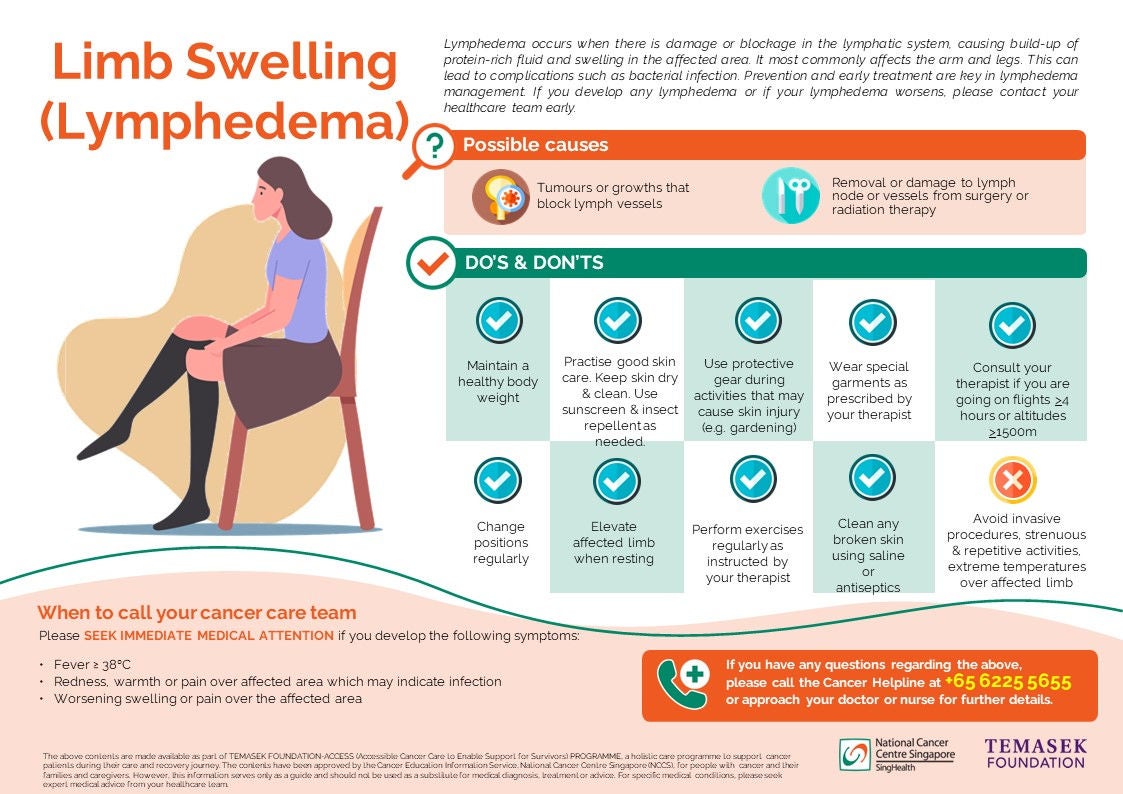National Cancer Centre Singapore will NEVER ask you to transfer money over a call. If in doubt, call the 24/7 ScamShield helpline at 1799, or visit the ScamShield website at www.scamshield.gov.sg.
Limb Swelling (Lymphedema)
- Allergies
- Appetite Loss
- Bone Problems
- Breathing Problems
- Constipation
- Diarrhoea
- Difficulty Swallowing (Dysphagia)
- Dry Mouth (Xerostomia)
- Difficulty Sleeping (Insomnia)
- Feeling Tired (Fatigue)
- Fevers and Infections
- Hair Loss
- Heart Problems
- Menopausal Symptoms
- Indigestion
- Joint Pains
- Limb Swelling (Lymphedema)
- Muscle Aches
- Nail Changes
- Nausea and Vomiting
- Pain
- Tingling or Numbness in Hands or Feet (Peripheral Neuropathy)
- Skin Changes
- Sore Mouth (Oral Mucositis)
- Taste Changes

The lymphatic system is part of the body’s circulation and immune system. Lymphedema occurs when there is damage or blockage in the lymphatic system, causing swelling (edema) in the affected area. Lymphedema usually affects an arm or leg, but it can also affect other parts of the body, such as the head and neck. Swelling usually develops slowly, over time. It may develop during treatment or it may start years after treatment.
Causes of Lymphedema
- Tumours or growths that block lymph vessels
- Removal or damage to lymph nodes or vessels from surgery, and / or radiation therapy
What you need to look out for
Lymphedema can be treated but results are best if done early. It is important to look out for the following symptoms and if present, to see your doctor or nurse to be assessed.
- Swelling that is soft to touch
- Heavy or achy feeling around the area
- Difficulty with movement
- Itch, redness, warmth, thickening or hardening of the skin
- Recurring skin infections

How it can be treated
Your doctor or nurse will first need to assess your condition and arrange for tests if necessary. They may then refer you to see a Physical or Occupational therapist, who will teach you exercises and self-massages, or recommend special compressive garments (e.g. stockings, arm sleeves) to help you manage the lymphedema.
Depending on your condition, your doctor may also refer you to a plastic surgeon, who will carry out further assessments to determine if you are a suitable candidate for surgical treatment. Surgical options include lympho-venous bypass, lymph node transfer and debulking surgery, depending on the severity of your lymphedema.
What you can do
The following are some of the do’s and don’ts to help you manage lymphedema and prevent further complications:
Ensure good skin care
|
|
Other measures
|
|
When to call your cancer care team
Please inform your doctor or nurse as soon as you notice symptoms of lymphedema or if you develop the following symptoms that may indicate worsening or complications of the condition.
- Redness, warmth or pain over the area of lymphedema which may indicate infection
- Worsening swelling or pain on movement of the affected are
If you have any questions regarding the above, please call the Cancer Helpline at +65 6225 5655 or approach your doctor or nurse for further details.
Click here to download the PDF version of this article.
如果您要下载本文的中文版本,请点击此处。
Klik di sini untuk memuat turun versi PDF artikel ini.
The above contents are made available as part of TEMASEK FOUNDATION-ACCESS (Accessible Cancer Care to Enable Support for Survivors) PROGRAMME, a holistic care programme to support cancer patients during their care and recovery journey.
The contents have been approved by the Cancer Education Information Service, National Cancer Centre Singapore (NCCS), for people with cancer and their families and caregivers. However, this information serves only as a guide and should not be used as a substitute for medical diagnosis, treatment or advice. For specific medical conditions, please seek expert medical advice from your healthcare team.
Brought to you by:
![]()
![]()
Keep Healthy With
© 2025 SingHealth Group. All Rights Reserved.

















